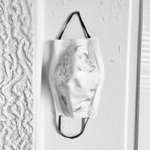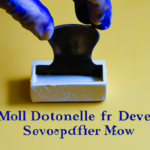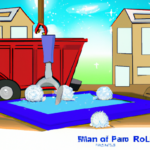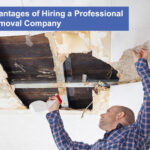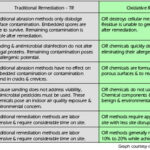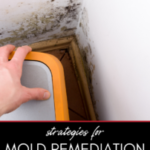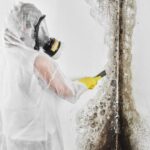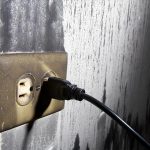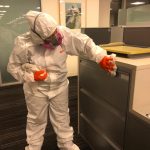Are you dealing with a mold problem in your home or business and in need of top-quality mold remediation solutions? Look no further than SERVPRO of West Pensacola. Located at 1101 S Fairfield Dr in Pensacola, FL, they are experts in mold remediation and can provide you with the assistance you need to eliminate mold and restore a clean and healthy environment. With their professional team and state-of-the-art equipment, you can trust that they will deliver exceptional results. Contact them at (850) 469-1160 or visit their website at http://servprowestpensacola.com/ to learn more about their mold remediation services.
Table of Contents
ToggleUnderstanding Mold
What is mold?
Mold is a type of fungus that grows in moist and humid environments. It reproduces by releasing spores into the air, which can then settle on various surfaces and grow into new colonies. Mold is commonly found in areas with water damage or high humidity, such as bathrooms, basements, and kitchens. It can appear in various colors and textures, including black, green, or fuzzy patches.
Common types of mold
There are several common types of mold that can be found in homes and buildings. Some of the most frequently encountered molds include:
-
Stachybotrys chartarum (black mold): This mold is often associated with water-damaged buildings and can release mycotoxins that are harmful to human health.
-
Aspergillus: This mold can be found both indoors and outdoors. It is known to cause respiratory issues, especially in individuals with weakened immune systems.
-
Penicillium: This mold can grow on various materials, such as damp walls, wallpaper, and insulation. It can cause allergies and respiratory problems.
-
Cladosporium: This mold can grow on surfaces like fabrics, carpets, and wood. It can trigger allergic reactions and asthma symptoms.
-
Alternaria: This mold is commonly found in damp areas like showers and sinks. It can cause allergic reactions and asthma attacks.
Health risks associated with mold
Exposure to mold can have adverse effects on your health. Some individuals are more sensitive to mold than others, and prolonged exposure can lead to the following health risks:
-
Respiratory issues: Breathing in mold spores can trigger respiratory problems, such as coughing, wheezing, and shortness of breath. It can also exacerbate symptoms in individuals with asthma or allergies.
-
Allergic reactions: Some people may develop allergic reactions to mold, including sneezing, runny nose, itchy eyes, and skin rashes.
-
Infections: Individuals with weakened immune systems or underlying health conditions may be at risk of developing fungal infections from exposure to certain molds.
-
Mycotoxin exposure: Certain types of mold, such as Stachybotrys chartarum, can release mycotoxins that can cause neurological symptoms, respiratory issues, and other health problems.
It’s important to address mold infestations promptly to minimize the health risks associated with exposure.
Signs of Mold Infestation
Visible signs of mold
Visible signs of mold growth can include discolored patches on walls, ceilings, or floors. Mold often appears as fuzzy, dark spots or powdery substances. Pay attention to areas with water damage, leaks, or excessive condensation, as these are prime breeding grounds for mold.
Musty odor
A musty odor is a telltale sign of mold infestation. If you notice a damp, earthy smell in specific areas of your home, it is likely that mold is present. Even if you can’t see any visible signs, the smell alone should prompt further investigation.
Allergic reactions
If you or your family members experience an increase in allergic symptoms, such as sneezing, coughing, or watery eyes when spending time in a particular area, it could be due to mold. Allergens produced by mold spores can trigger allergic reactions in sensitive individuals.
Water damage indicators
Mold often thrives in areas with water damage or excessive moisture. Look out for signs such as peeling paint, bubbling wallpaper, warped surfaces, or staining, as these can indicate underlying moisture issues. It is crucial to address these problems promptly to prevent mold growth.
Importance of Mold Remediation
Prevention of health issues
mold remediation plays a vital role in preventing health issues associated with mold exposure. By removing existing mold colonies and addressing the underlying moisture problems, you can minimize the risk of respiratory problems, allergic reactions, and other health complications.
Preventing structural damage
Mold can cause structural damage to your home or building if left untreated. It can weaken the integrity of walls, floors, and ceilings, leading to costly repairs and potential safety hazards. Mold remediation helps prevent further deterioration and preserves the structural integrity of your property.
Improving indoor air quality
Mold releases spores and other airborne particles that can significantly impact indoor air quality. These particles can be inhaled, causing respiratory issues and allergic reactions. By removing mold and improving ventilation, mold remediation enhances the overall indoor air quality, creating a healthier living environment.
Avoiding the spread of mold
Mold can spread quickly if not properly contained and removed. The microscopic spores can become airborne and settle in other areas, leading to new mold growth. Professional mold remediation techniques help contain the mold infestation, preventing the further spread of spores and minimizing the likelihood of recurring mold problems.
Professional Mold Inspection
Qualifications and certifications
When choosing a mold remediation service, ensure they have the necessary qualifications and certifications. Look for certifications such as the Institute of Inspection, Cleaning and Restoration Certification (IICRC). These certifications indicate that the technicians have undergone proper training and adhere to industry standards.
Thorough mold assessment
A professional mold inspection involves a thorough assessment of your property to identify the extent of the mold infestation. This includes inspecting visible signs of mold, checking hidden areas, and sampling the air and surfaces to determine the types and concentrations of mold present.
Identification of moisture sources
To effectively address mold growth, it is essential to identify and address the moisture sources that are promoting it. A professional mold inspection will include an evaluation of areas prone to water damage, plumbing leaks, or excessive humidity. By addressing these issues, the underlying cause of mold growth can be eliminated.
Documentation and reporting
A reputable mold remediation service will provide you with a detailed report documenting the findings of the inspection. This report should include information on the extent of the mold infestation, the types of mold present, and recommendations for remediation. It serves as a valuable reference and helps track the progress of mold removal.
Effective Mold Removal Techniques
Containment and isolation
During the mold removal process, it is important to contain and isolate the affected areas. This helps prevent the spread of mold spores to other parts of the property. Techniques such as the use of physical barriers, negative air pressure, and sealing off HVAC systems are employed to minimize cross-contamination.
Air filtration and purification
High-efficiency particulate air (HEPA) filtration systems are commonly used during mold remediation to clean the air of mold spores and other airborne contaminants. These filtration systems can effectively capture particles as small as 0.3 microns, ensuring cleaner and healthier air.
Removal of mold-infested materials
Any materials or surfaces affected by mold growth need to be removed and properly disposed of. This may include drywall, insulation, carpeting, or other porous materials that cannot be effectively cleaned. Removing these mold-infested materials is essential to prevent spore release and minimize the risk of recontamination.
Cleaning and disinfection
Non-porous surfaces that can be salvaged are thoroughly cleaned and disinfected during mold remediation. Specialized cleaning solutions and techniques are used to kill and remove any remaining mold spores. This step helps ensure that the affected surfaces are restored and ready for use.
Advanced Equipment and Tools
HEPA air scrubbers
HEPA air scrubbers are powerful filtration devices that help remove mold spores and other contaminants from the air. These machines use HEPA filters to capture particles as small as 0.3 microns, ensuring that the air is effectively cleaned during the mold removal process.
High-efficiency vacuums
High-efficiency vacuums equipped with HEPA filters are used to clean up settled mold spores and debris from surfaces. These vacuums prevent the spores from becoming airborne and spreading to other areas. The HEPA filters in the vacuums ensure that the captured particles are not released back into the environment.
Moisture meters
Moisture meters are used to measure the moisture content in various materials and identify areas with increased humidity. These devices help detect hidden sources of moisture, such as leaks or condensation, which can contribute to mold growth. By locating and addressing these moisture sources, further mold growth can be prevented.
Thermal imaging cameras
Thermal imaging cameras are utilized during mold inspections to identify areas with hidden moisture or temperature differences. These cameras detect temperature variations, which can indicate areas of potential mold growth. By using thermal imaging cameras, technicians can pinpoint areas that require further investigation and remediation.
Safe Handling of Mold Contamination
Protective equipment for technicians
Technicians performing mold remediation wear personal protective equipment (PPE) to ensure their safety. This may include gloves, masks or respirators, goggles, and coveralls. PPE helps prevent direct contact with mold spores and minimizes the risk of respiratory issues or skin irritation.
Proper disposal of mold-infested materials
Mold-infested materials that are removed during the remediation process need to be handled and disposed of properly. This prevents further contamination and the risk of spreading mold spores. Mold remediation services should follow industry guidelines for safe disposal, ensuring that the materials are securely sealed and taken to appropriate disposal sites.
Preventing cross-contamination
To minimize the risk of cross-contamination, containment measures are implemented during mold removal. This includes isolating the affected areas, sealing off HVAC systems, and using appropriate procedures to prevent the spread of mold spores. It is vital to ensure that mold remediation is carried out in a controlled manner to prevent the contamination of unaffected areas.
Preventive Measures
Fixing moisture problems
Addressing moisture problems is crucial to preventing mold growth in the first place. This may involve repairing leaks, improving ventilation, or installing dehumidifiers in moisture-prone areas. By eliminating excessive moisture, you can create an environment that is less favorable for mold growth.
Improving ventilation
Proper ventilation helps control humidity levels and remove moisture from the air, reducing the likelihood of mold growth. Ensure that bathrooms, kitchens, laundry rooms, and other areas prone to moisture have adequate ventilation systems in place. This may include exhaust fans, opening windows, or using dehumidifiers.
Controlling humidity levels
Maintaining optimal humidity levels is key to preventing mold growth. The ideal indoor humidity level is between 30% and 50%. Use dehumidifiers in humid areas and monitor humidity levels regularly. By controlling moisture, you can create an environment that is less hospitable to mold.
Regular inspections and maintenance
Regular inspections and maintenance are essential for early detection and prevention of mold growth. Inspect your property for signs of water damage, leaks, or excessive moisture. Address any issues promptly to prevent mold growth from taking hold. Additionally, regular maintenance of HVAC systems and proper cleaning can help ensure a healthy indoor environment.
Post-Remediation Verification
Visual inspection
After mold remediation, a visual inspection should be conducted to ensure that all visible traces of mold have been successfully removed. A trained professional will carefully inspect the treated areas to confirm that they are free of mold growth and have been properly restored.
Air quality testing
Air quality testing is often conducted after mold remediation to assess the effectiveness of the removal process. Samples of the air are collected and analyzed to determine the mold spore count and overall air quality. This testing ensures that the mold remediation efforts have resulted in a healthier indoor environment.
Documentation and certification
Once the mold removal process is complete, you should receive documentation and certification from the mold remediation service. This documentation serves as proof that the remediation was carried out by qualified professionals and that the affected areas were properly treated. It provides peace of mind knowing that the mold issue has been effectively resolved.
Choosing a Reliable Mold Remediation Service
Certifications and licenses
When selecting a mold remediation service, ensure that they hold the necessary certifications and licenses. Look for certifications from reputable organizations such as the IICRC, which demonstrate that the company employs trained professionals who adhere to industry standards.
Experience and expertise
Consider the experience and expertise of the mold remediation service before making a decision. Look for established companies with a proven track record in successfully addressing mold issues. Experienced professionals will have the knowledge and skills to handle various mold situations and offer effective solutions.
Customer testimonials
Check for customer testimonials and reviews to gauge the quality of service provided by the mold remediation company. Positive reviews and recommendations from satisfied customers indicate a reliable and trustworthy service. Consider reaching out to past clients to ask about their experience and satisfaction with the company’s work.
Insurance coverage and guarantees
Verify that the mold remediation service has appropriate insurance coverage. This ensures that you and your property are protected in case of any potential damages or accidents during the remediation process. Additionally, inquire about any guarantees or warranties offered by the company to ensure that their work is backed by a commitment to customer satisfaction.
By following these guidelines and choosing a reliable mold remediation service, you can effectively address mold issues in your home or building, ensuring a safe and healthy living environment for you and your loved ones.






